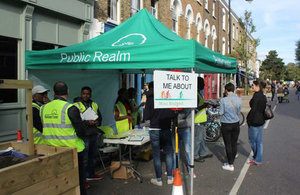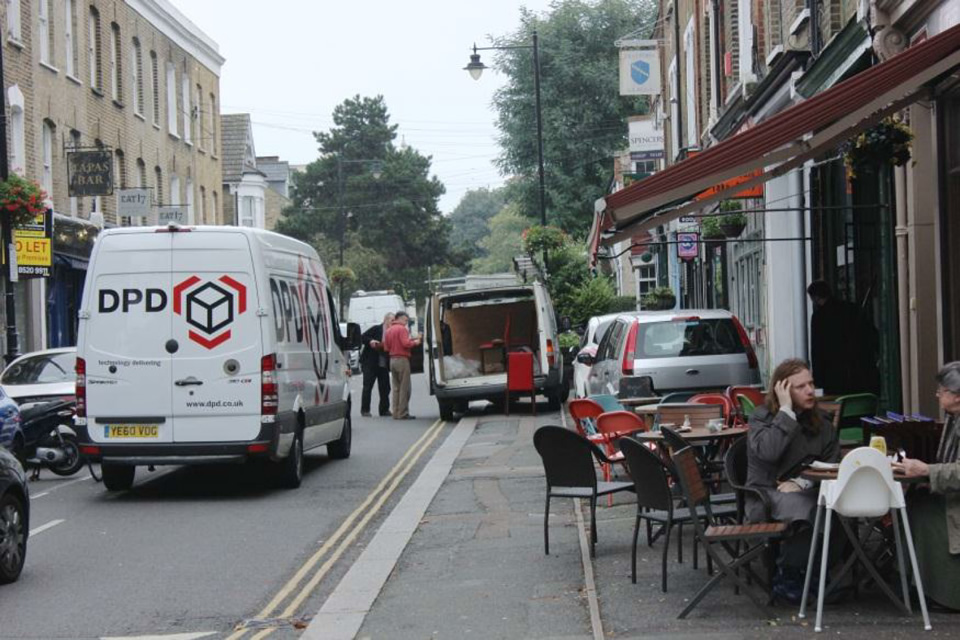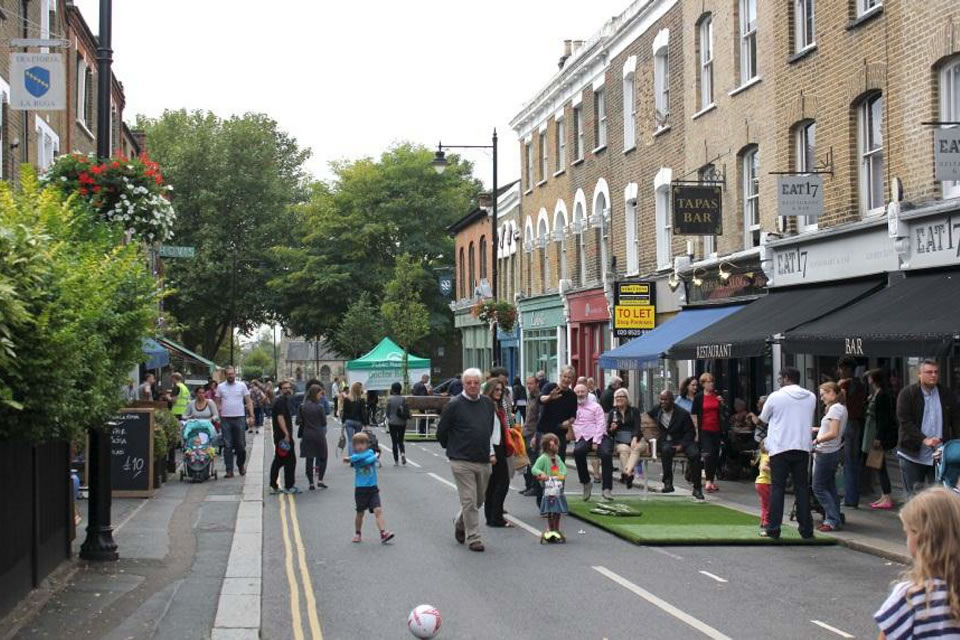Changing roads to public spaces in Walthamstow Village
The London Borough of Waltham Forest has trialled changing roads into public spaces to reduce traffic, improve safety and encourage sustainable travel.

What we did
London Borough of Waltham Forest trialled an integrated set of measures to reallocate road space to public space. The measures we took included:
- roads closed except to buses and cycles (8 filter locations), and all parking suspended
- roads changed to two-way working
- a road changed to one-way working
- additional cycle parking
- landscaping and public art

Walthamstow Village Area trial road closures September to October (image courtesy of London Borough of Waltham Forest).
Raised road crossings, a pedestrian crossing and junction improvements were also implemented as part of the permanent scheme.
We dramatically reduced the amount of non-local traffic by restricting access to motor traffic at various locations. This meant we were able to reallocate road space to public space without affecting business servicing, properties and local private journeys. Non-local through traffic was redirected onto the main road network. We monitored the impact of this on traffic flow at major junctions as part of the pilot process.
Why we did it
A high proportion of vehicles using Walthamstow Village were exploiting it as a cut-through between surrounding main roads, often at high speed.
The objectives were to:
- reduce the amount and speed of through-traffic using residential streets
- improve the look, feel and safety of Walthamstow Village for all road users
- encourage environmentally sustainable travel choices
- create a ‘living consultation’ to enable residents and businesses to experience the changes in real life

Street conditions in Walthamstow Village before the trial.
We had identified the area around Pembroke Road in Walthamstow Village for a neighbourhood improvement. The local residents’ association had long campaigned for pedestrianising the main shopping street because it was badly affected by through traffic. A successful bid to Transport for London for ‘Mini-Holland’ funding made the scheme possible.
Part of the Mayor’s Vision for Cycling in London, ‘Mini-Hollands’ is a programme that focuses investment in better streets for walking and cycling on town centres in 3 outer London boroughs. It’s intended to encourage people to walk or cycle short local trips rather than make them by car.
How we did it
In February 2014 we carried out a survey to understand the main concerns of local residents and businesses. Two key issues were raised:
- traffic volumes
- speeding on residential roads
We took the opportunity presented by the Mini-Holland funding to give residents, businesses and other interested parties the chance to improve their surroundings and local environment.
We introduced a series of temporary road closures to reduce the amount of non-local traffic whilst still allowing local access for people walking or cycling.
Scheme delivery followed a 7 stage strategy:
- gather baseline information, early engagement and initial communications
- trial road closures
- results and feedback from the Walthamstow Village trial
- development of final proposals for public consultation
- public consultation (post-trial engagement)
- implementation
- review

Walthamstow Village Area Mini Holland during the trial.
This approach ensured that the scheme was suitable for residents by providing opportunities for information to be distributed and for residents and businesses to give feedback.
By conducting a trial of road closures, the information gained can be used to inform future schemes without the need to implement such time-intensive trials, so stages 2 and 3 above will be omitted from future delivery approaches.
The aim was to gauge the effectiveness of the road closures and allow us to make sure the measures were implemented in the correct locations whilst minimising the implications for the residents. The success of each intervention could then be assessed and implemented on a larger scale throughout the rest of Walthamstow Village and two other villages.
The trial gathered real life traffic data and enabled residents, schools and businesses to experience at first hand what it could feel like having the road closures in place in their area.
The very extensive consultation process was a fresh approach to street design, and the Walthamstow Village Trial was the first of its kind in the UK. We distributed a consultation pack to households, attracted significant local press coverage, and held numerous drop-in sessions, public meetings and design workshops. Council officers spoke to over 1,500 residents through door knocking, we ran surveys, and met with emergency services, religious institutions, schools and the Dial-a-Ride service.
During the engagement period we responded to 900 emails, over 200 residents attended design workshops, over 100 residents attended drop in sessions, and 18% of households within the consultation area responded to the consultation questionnaire (10% is normal).

Orford Road after completion.
After the trial period we invited local business owners to a meeting to discuss the trial and the proposed improvements, so they could provide feedback on the trial and offer suggestions and ideas to help the scheme work better.
The trial directly helped us achieve our overall programme of improvement. By undertaking it in this way, the pilot created a ‘live consultation’ document that enabled interested parties from neighbouring boroughs and further afield to experience how the area might change if the permanent scheme were to be introduced.
What we learned
The scheme reduced the average daily flow throughout the area from 8,493 to 4,808 vehicles. Overall, the number of vehicles reduced by 22% and the average traffic speed reduced from 22.3mph to 21mph, bringing it closer to the 20mph limit.
User feedback
The consultation results showed that 74% were in favour of safer environmental proposals.
A local resident:
I’d just like to say I fully support the scheme. The nearby railway bridge road closures have already had a dramatic effect on the area. It’s much quieter and feels safer. I’m sure it will encourage people to cycle and walk more. I hope very much that the closures will be made permanent (I have a car by the way).
Communications
Communication is a key element of such a scheme’s success. It’s vital to provide clear information so that residents are engaged and understand the reasons for the scheme, and the wider benefits.
The trial generated a lot of interest as part of the Mini-Holland programme. This high profile meant we needed to involve a wider audience and work more closely with other stakeholders, council departments and councillors to make sure they were aware the implications for their work.
During the trial additional changes were made to the engagement plan to ensure that the level of communication was appropriate. This included a large number of staff on site throughout the day and door-knocking in the evening to ensure residents and businesses knew what was happening and could give feedback, which proved hugely popular.
Digital and social media
Social media played an unexpectedly large part in sharing information about the scheme and forming opinions. We created new media tools including a Twitter account and a schemes-specific microsite to quickly correct wrong information.
Future public involvement will be largely web-based – using online forms and innovative websites such as Commonplace – to minimise officer time input. A challenge of these methods is to guarantee inclusive access to them.
The Chartered Institute of Highways and Transportation has useful guidelines on involving the public and other stakeholders.
Contact and further information
For further information:
- email [email protected]
- visit the Enjoy Waltham Forest website